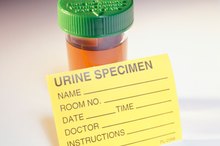What does fact checked mean?
At Healthfully, we strive to deliver objective content that is accurate and up-to-date. Our team periodically reviews articles in order to ensure content quality. The sources cited below consist of evidence from peer-reviewed journals, prominent medical organizations, academic associations, and government data.
The information contained on this site is for informational purposes only, and should not be used as a substitute for the advice of a professional health care provider. Please check with the appropriate physician regarding health questions and concerns. Although we strive to deliver accurate and up-to-date information, no guarantee to that effect is made.
Leukocytes in Urine Without Infection
Urinary tract infections are detected at the clinical laboratory by through chemical analysis of the urine and microscopic confirmation. To counteract the infection, white blood cells migrate to the site of the infection. Detection of white blood cells in the urine is often indicative of a urinary tract infection. However, sometimes white blood cells are detected even when there is no infection.
White Blood Cells
White blood cells are the main component of the body's immune system. They engulf and destroy invading organisms like viruses and bacteria. They also release antibodies to inactivate organisms and toxins. When cells in the body detect an infection, white blood cells move to the site of infection and begin to work. When the infection is in the kidneys, white blood cells will be found in the urine.
- White blood cells are the main component of the body's immune system.
- When cells in the body detect an infection, white blood cells move to the site of infection and begin to work.
Urine Leukocyte Esterase
Causes of WBCs and RBCs in Urine
Learn More
Normal urine does not contain any white blood cells. A quick way to detect white blood cells in urine is to look for leukocyte esterase, an enzyme found in the white blood cells. When a urine sample is sent to the laboratory for analysis, the lab tech will dip a stick coated with different chemicals into the urine.
Depending on the urine's chemical composition, the chemicals on the stick will change color. If leukocyte esterase is found, microscopic analysis is usually indicated to confirm the findings as false positive tests are possible.
- Normal urine does not contain any white blood cells.
- A quick way to detect white blood cells in urine is to look for leukocyte esterase, an enzyme found in the white blood cells.
Microscopic Urinalysis
A microscopic urinalysis is indicated to confirm the findings of the chemical urinalysis. This is because certain foods and medications can have an effect on urine's chemistry to the point of causing false positive results. So the laboratory may report leukocytes in urine without the patient really having an infection. If the white blood cells really are in the urine, the lab tech will see them through the microscope.
- A microscopic urinalysis is indicated to confirm the findings of the chemical urinalysis.
- So the laboratory may report leukocytes in urine without the patient really having an infection.
Pyuria
What Does Positive Leukocytes Mean?
Learn More
Pyuria is a term used to describe white blood cells in the urine. While most cases of pyuria are due to a true urinary tract infection, some cases are observed in patients without an infection. This happens when there is physical damage to the urinary tract, as is the case when kidney stones are passed. The white blood cells are a result of inflammation, not infection. There are also some conditions in which the number of white blood cells in blood is very high, artificially increasing the concentration of esterase in the blood and, subsequently, the urine.
- Pyuria is a term used to describe white blood cells in the urine.
- There are also some conditions in which the number of white blood cells in blood is very high, artificially increasing the concentration of esterase in the blood and, subsequently, the urine.
Considerations
Only laboratory professionals can properly test urine for the presence of white blood cells and other abnormalities. Licensed health care providers are the only ones that can recommend and implement a course of treatment to correct the cause of pyuria or urinary tract infections. A constant feeling of having to urinate, painful or burning urination, urine of an abnormal color, and pelvic or abdominal pain are all reasons to schedule a visit to check for an infection or any other disorder.
Related Articles
References
- MedLine Plus
- University of Utah
- Perrier ET, Johnson EC, McKenzie AL, Ellis LA, Armstrong LE. Urine colour change as an indicator of change in daily water intake: a quantitative analysis. Eur J Nutr. 2016;55(5):1943–1949. doi:10.1007/s00394-015-1010-2
- Cortes-Penfield NW, Trautner BW, Jump RLP. Urinary Tract Infection and Asymptomatic Bacteriuria in Older Adults. Infect Dis Clin North Am. 2017;31(4):673–688. doi:10.1016/j.idc.2017.07.002
- Dreger NM, Degener S, Ahmad-Nejad P, Wöbker G, Roth S. Urosepsis--Etiology, Diagnosis, and Treatment. Dtsch Arztebl Int. 2015;112(49):837–848. doi:10.3238/arztebl.2015.0837
- Jump RL, Crnich CJ, Nace DA. Cloudy, Foul-Smelling Urine Not a Criteria for Diagnosis of Urinary Tract Infection in Older Adults. J Am Med Dir Assoc. 2016;17(8):754. doi:10.1016/j.jamda.2016.04.009
- Kang KK, Choi JR, Song JY, et al. Clinical significance of subjective foamy urine. Chonnam Med J. 2012;48(3):164–168. doi:10.4068/cmj.2012.48.3.164
- Blackburn PR, Gass JM, Vairo FPE, et al. Maple syrup urine disease: mechanisms and management. Appl Clin Genet. 2017;10:57–66. Published 2017 Sep 6. doi:10.2147/TACG.S125962
- Prakash S, Saini S, Mullick P, Pawar M. Green urine: A cause for concern?. J Anaesthesiol Clin Pharmacol. 2017;33(1):128–130. doi:10.4103/0970-9185.202190
- Torres PA, Helmstetter JA, Kaye AM, Kaye AD. Rhabdomyolysis: pathogenesis, diagnosis, and treatment. Ochsner J. 2015;15(1):58–69. PMID: 25829882
- Rehfuss A, Mahon J, Sorokin I, Smith C, Stein BS. Phenazopyridine: A Preoperative Way to Identify Ureteral Orifices. Urology. 2018;115:36-38. doi:10.1016/j.urology.2018.02.023
- American Urological Association. Diagnosis, Evaluation and Follow-up of Asymptomatic Microhematuria (AMH) in Adults. 2016.
- Worku DA. Purple urine bag syndrome: An unusual but important manifestation of urinary tract infection. Case report and literature review. SAGE Open Med Case Rep. 2019;7:2050313X18823105. Published 2019 Jan 12. doi:10.1177/2050313X18823105
- Alkaptonuria. National Institutes of Health. Genetic and Rare Diseases Information Center. 3/18/2016
- Seo JW, Lee JH, Son IS, et al. Acute oxalate nephropathy caused by ethylene glycol poisoning. Kidney Res Clin Pract. 2012;31(4):249–252. doi:10.1016/j.krcp.2012.09.007
- Urinalysis. Visual Examination. Lab Tests Online. https://labtestsonline.org/understanding/analytes/urinalysis/ui-exams
Writer Bio
Rene Najera has been writing about health-related issues for over five years through different media. He holds a Master of Public Health degree from the George Washington University and conducts infectious disease surveillance at a state health department. He has also been a lab professional for over 14 years.





